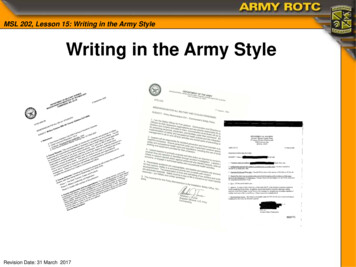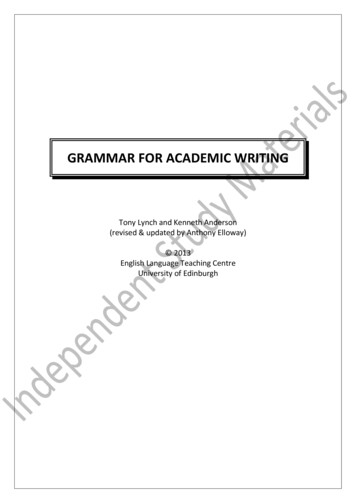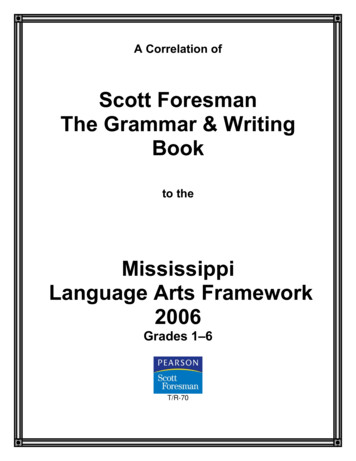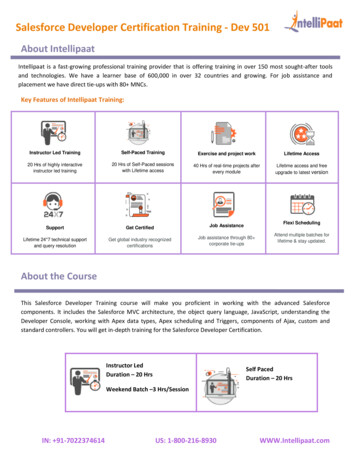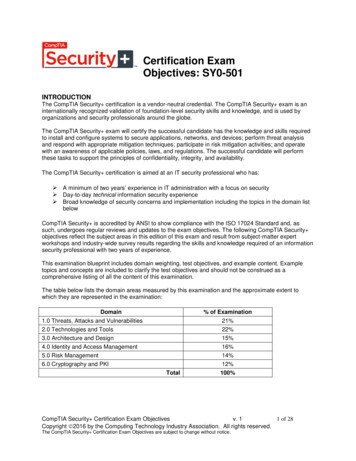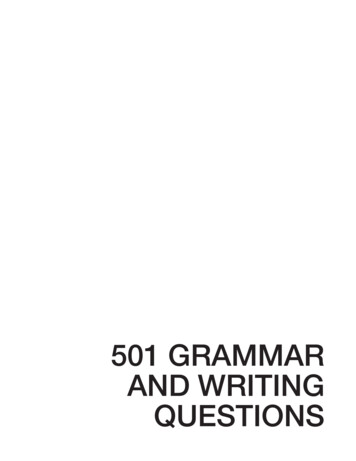
Transcription
501 GRAMMARAND WRITINGQUESTIONS
501 GRAMMARAND WRITINGQUESTIONS3rd Edition N E WY O R K
Copyright 2006 LearningExpress, LLC.All rights reserved under International and Pan-American Copyright Conventions.Published in the United States by LearningExpress, LLC, New York.Library of Congress Cataloging-in-Publication Data501 grammar & writing questions.—3rd ed.p. cm.ISBN 1-57685-539-21. English language—Grammar—Examinations, questions, etc. 2. English language—Rhetoric—Examinations, questions, etc. 3. Report writing—Examinations, questions,etc. I. Title: 501 grammar and writing questions. II. Title: Five hundred one grammarand writing questions. III. Title: Five hundred and one grammar and writing questions.PE1112.A15 2006428.2'076—dc222005035266Printed in the United States of America987654321Third EditionISBN 1-57685-539-2For more information or to place an order, contact LearningExpress at:55 Broadway8th FloorNew York, NY 10006Or visit us at:www.learnatest.com
ContentsINTRODUCTIONviiSECTION 1Mechanics: Capitalization and PunctuationSECTION 2Sentence Structure11SECTION 3Agreement29SECTION 4Modifiers43SECTION 5Paragraph Development49SECTION 6Essay Questions95ANSWERS1103v
IntroductionThis book—which can be used alone, along with another writing-skills text of your choice, or in combination with the LearningExpress publication, Writing Skills Success in 20 Minutes a Day—will giveyou practice dealing with capitalization, punctuation, basic grammar, sentence structure, organization, paragraph development, and essay writing. It is designed to be used by individuals working on their own andfor teachers or tutors helping students learn or review basic writing skills. Additionally, practicing with 501 Grammar and Writing Questions will greatly alleviate writing anxiety.Many people grimace when faced with grammar exercises. But in order to communicate with others, passtests, and get your point across in writing, using words and punctuation effectively is a necessary skill. Maybe you’reone of the millions of people who, as a student in elementary or high school, found memorizing grammar rulestedious. Maybe you were confused by all of the exceptions to those rules. Maybe you thought they would just comenaturally as you continued to write and speak.First, know you are not alone. It is true that some people work very hard to understand the rules, while others seem to have a natural gift for writing. And that’s okay; we all have unique talents. Still, it’s a fact that mostjobs today require good communication skills, including writing. The good news is that grammar and writing skillscan be developed with practice.vii
– INTRODUCTION – Learn by doing. It’s an old lesson, tried and true.The 501 grammar and writing questions included inthese pages are designed to provide you with lots ofpractice. As you work through each set of questions,you’ll be gaining a solid understanding of basic grammar and usage rules. And all without memorizing!This book will help you improve your language skillsthrough encouragement, not frustration. How to Use This BookWhether you’re working alone or helping someonebrush up on grammar and usage, this book will giveyou the opportunity to practice, practice, practice.Working on Your OwnIf you are working alone to review the basics or preparefor a test in connection with a job or school, you willprobably want to use this book in combination with abasic grammar and usage text, or with Writing SkillsSuccess in 20 Minutes a Day. If you’re fairly sure of yourbasic language-mechanics skills, however, you can use501 Grammar and Writing Questions by itself.Use the answer key at the end of the book not onlyto find out if you chose the right answer, but also tolearn how to tackle similar kinds of questions nexttime. Every answer is explained. Make sure you understand the explanations—usually by going back to thequestions—before moving on to the next set.An Over view501 Grammar and Writing Questions is divided intosix sections:Section 1: Mechanics: Capitalization andPunctuationSection 2: Sentence StructureSection 3: AgreementSection 4: ModifiersSection 5: Paragraph DevelopmentSection 6: Essay QuestionsTutoring OthersThis book will work well in combination with almostany basic grammar and usage text. You will probablyfind it most helpful to give students a brief lesson in theparticular skill they’ll be learning—capitalization,punctuation, subject-verb agreement, pronoun agreement, sentence structure, style—and then have themspend the remainder of the session answering the questions in the sets. You will want to impress upon themthe importance of learning by doing, checking theiranswers, and reading the explanations carefully. Makesure they understand a particular set of questionsbefore you assign the next one.Each section is subdivided into short sets consisting of 8–20 questions.The book is specifically organized to help youbuild confidence as you further develop your writtenlanguage skills. 501 Grammar and Writing Questionsbegins with the basic mechanics of capitalizationand punctuation, and then moves on to grammar andsentence structure. By the time you reach the sectionon paragraph development, you’ve already practiced onalmost 300 questions. You will then continue practicing the skills you’ve already begun to master in theprevious four sections, this time, in combination.When you get to the last section, you’ll be ready towrite your own essays.viii
– INTRODUCTION – Grammatically Correct: The Writer’s Essential Guide toPunctuation, Spelling, Style, Usage and Grammar byAnne Stilman (Writers Digest Books)Additional ResourcesFor more detailed explanations of English grammarand usage rules, you may want to buy—or borrowfrom the library—one or more of the following books:The Oxford Dictionary of American Usage and Style byBryan A. Garner (Berkley Publishing Group)Action Grammar: Fast, No-Hassle Answers on EverydayUsage and Punctuation by Joanne Feierman (Fireside)Quick Review Writing: Grammar, Usage, and Style byJean Eggenschwiler and Emily Dotson Biggs (CliffsNotes)The American Heritage Book of English Usage: A Practical and Authoritative Guide to Contemporary English(Houghton Mifflin)Woe is I: The Grammarphobes Guide to Better English inPlain English, 2nd Edition, by Patricia T. O’Conner(Riverhead Books)The Blue Book of Grammar and Punctuation: The Mysteries of Grammar and Punctuation Revealed by JaneStraus (Jane Straus Books)Writing Skills Success in 20 Minutes a Day, 3rd Edition(LearningExpress)Grammar Smart: A Guide to Perfect Usage, 2nd Edition(Princeton Review)Writing Smart: Your Guide to Great Writing, 2nd Edition, by Marcia Lerner (Princeton Review)ix
501 GRAMMARAND WRITINGQUESTIONS
S E C T I O N1Mechanics:Capitalization andPunctuationSince every sentence begins with a capital, the how-to’s of capitalization seem like a logical place tobegin learning about language mechanics. When doing the exercises in this section, refer to thefollowing checklist. Matching your answer to a rule will reinforce the mechanics of writing andsecure that knowledge for you. Capitalization Checklist The first word of every sentence Yes, we do carry the matching bed skirt. The first word of a quoted sentence (not just a quoted phrase) And with great flourish, he sang, “O beautifulfor gracious skies, for amber waves of grain!” The specific name of a person (and his or her title), a place, or a thing (otherwise known as proper nouns). Propernouns include specific locations and geographic regions; political, social, and athletic organizations and agencies; historical events; documents and periodicals; nationalities and their language; religions, their membersand their deities; brand or trade names; and holidays. The abbreviation for proper nouns. Government agencies are probably the most frequently abbreviated.Remember to capitalize each letter. The CIA makes me feel very secure. Adjectives (descriptive words) derived from proper nouns.Ex: America (proper noun) the American (adjective) flag The pronoun I. The most important words in a title Last March, I endured a twenty-hour public reading of A Tale of Two Cities.1
– MECHANICS: CAPITALIZATION AND PUNCTUATION – Punctuation ChecklistSemicolons Between two independent clauses (an independent clause is a complete thought. It has a subject anda predicate.) Edward joined the basketball team;remarkably, the 5 4 young man excelled at the sport. Between elements in a series that uses commas The possible dates for the potluck dinner are Thursday, June 5; Saturday, June 7; or Monday, June 9.Periods At the end of a declarative sentence (sentence thatmakes a statement) Today, I took a walk tonowhere. At the end of a command or request Here’s a cloth.Now gently burp the baby on your shoulder. At the end of an indirect question Jane asked if Iknew where she had left her keys. Before a decimal number Statisticians claim thatthe average family raises 2.5 children. Between dollars and cents I remember when 1.50could buy the coolest stuff. After an initial in a person’s name You are SirJames W. Dewault, are you not? After an abbreviation On Jan. 12, I leave for Africa.Colons Between two complete ideas when the second ideaexplains the first. Keri pushed her dinner away:She had eaten on the car ride home. Before a list Grandma brought Chloe’s favoritethree sweets: chocolate kisses, Tootsie Rolls, and aSnickers bar. Between titles and subtitles Finding Your DreamHome: A Buyer’s Guide. Between volumes and page numbers MarvelComics 21:24 Between chapters and verse Job 4:12 Between hours and minutes It’s 2:00 a.m.—timeto sleep.Question Marks At the end of a question Why do you look so sad? Inside a quotation mark when the quote is a question She asked, “Why do you look so sad?”Exclamation Points At the end of a word, phrase, or sentence filled withemotion Hurry up! I cannot be late for the meeting! Inside a quotation mark when the quote is an exclamation The woman yelled, “Hurry up! I cannot belate for the meeting!”Apostrophes Where letters or numbers have been deleted—as ina contraction I looked at my father and whispered,“It’s (It is) okay to cry every so often.” At the end of a name where there is ownership(remember to also add an s after the apostrophe ifthe word or name does not end in an s already) Mary Jane’s horse sprained his ankle duringpractice.Quotation Marks When directly quoting dialogue, not when paraphrasing Hamlet says, “To be, or not to be. That isthe question.” For titles of chapters, articles, short stories, poems,songs, or periodicals My favorite poem is “TheRoad Not Taken.”2
–– MECHANICS: CAPITALIZATION AND PUNCTUATION –– Around nonessential clauses, parenthetical phrases,and appositives (A nonessential or nonrestrictiveclause is a word or group of words that are not necessary for the sentence’s completion; a parenthetical phrase interrupts the flow of a sentence; and anappositive is a word or group of words that renamethe noun preceding them) Matt’s mother, Janie(appositive), who has trouble with directions (nonessential clause), had to ask for help. After introductory words, phrases, and clauses Hoping for the best, we checked our luggage. Before conjunctions (Conjunctions are words thatlink two independent clauses together) Drewwanted to experience ballroom dancing before hiswedding, so he signed up for lessons at a local hall.Commas Between items in dates and addresses Michaelarrived at Ellis Island, New York, on February 14,1924. Between words in a list The university hired awoman to direct the Bursar’s, Financial Aid, and Registrar’s offices. Between equally important adjectives (be careful not to separate adjectives that describe eachother) The reporter spoke with several intense, talented high school athletes. After a tag that precedes a direct quote Davidwhined, “I am famished.” In a quote that precedes a tag and is not a questionor an exclamation “I am famished,” whined David.SET 1 (Answers begin on page 103.)For the following questions, choose the lettered part of the sentence that contains a word that needs a capitalletter. If no additional words should be capitalized, choose answer e. Refer to the checklist at the beginning ofthe chapter if you want to be certain about your answer.1. Last week, dr. Tanya Miller received a special award from the city of Atlanta. Noneabcde2. The new bakery in the center of town sells a wide assortment of italian pastries. Noneabcde3. Michael Blake, jr., is such an accomplished golfer that he won three tournaments in a row. Noneabcde4. Catherine complained loudly, “why can’t you ever pick me up on time in the morning?” Noneabcde5. The Declaration of Independence is one of the most important documents in the history abcof the United States. Nonede6. Sally’s Sweet shop, one of the oldest businesses in town, is located on one of the main streets abcof Millersville. Nonede3
–– MECHANICS: CAPITALIZATION AND PUNCTUATION ––7. My first childhood pet, a gray cat named otis, was given to me as a gift on my fifth birthday. Noneabcde8. The local elementary school is organizing a screening of the movie toy story as a fundraiser. Noneabcde12. Lily is an accomplished gymnast she won threemedals in her last competition.a. ;b. ,c. ?d. :e. NoneSET 2 (Answers begin on page 103.)Choose the punctuation mark that is needed in eachof the following sentences. If no additional punctuationis needed, choose answer e.9. “It isn’t fair!” shouted Martin. Coach Lewisnever lets me start the game!”a. .b. ,c. !d. “e. none13. Everyone was shocked when Max Smithfield—a studious, extremely bright high school seniordecided that college was not for him.a. ;b. ,c. –d. :e. none10. Maureen’s three sisters, Molly, Shannon, andPatricia are all spending the summer at theirgrandmother’s beach house.a. ;b. –c. !d. ,e. none14. Kims assistant, usually so reliab
you’ll be gaining a solid understanding of basic gram-mar and usage rules. And all without memorizing! This book will help you improve your language skills through encouragement, not frustration. An Overview 501 Grammar and Writing Questionsis divided into six sections: Section 1: Mechanics: Capitalization and Punctuation Section 2: Sentence Structure Section 3: Agreement Section 4 .



